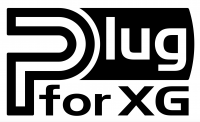XG Plug-in System: Difference between revisions
Jump to navigation
Jump to search
m (→See also) |
(Explain what makes it special and link to MU100 as example of first module) |
||
| Line 1: | Line 1: | ||
{{stub}} | {{stub}} | ||
[[File:XG Plug-in System logo.png|200px|right|thumb|The XG Plug-in System logo.]] | [[File:XG Plug-in System logo.png|200px|right|thumb|The XG Plug-in System logo.]] | ||
The '''XG Plug-in System''' is a system developed by Yamaha for expanding [[Yamaha XG]] tone generators.<ref name=mu100-om-plg>[https://usa.yamaha.com/files/download/other_assets/5/333985/MU100E1.pdf Yamaha MU100 Owner's Manual], page 163.</ref> Yamaha produced a series of expansion boards for this system.<ref name=mu100-om-plg /> | The '''XG Plug-in System''' is a system developed by Yamaha for expanding [[Yamaha XG]] tone generators.<ref name=mu100-om-plg>[https://usa.yamaha.com/files/download/other_assets/5/333985/MU100E1.pdf Yamaha MU100 Owner's Manual], page 163.</ref> Yamaha produced a series of "plug-in boards" (expansion boards) for this system.<ref name=mu100-om-plg /> Unlike some other expansion board systems (e.g. the [[Roland SR-JV80 series]]), these boards do not just add new sounds, but contain an entire synthesis or effects engine on a board, thus providing more polyphony and additional capabilities to the synths they are installed in. | ||
== References == | == References == | ||
Revision as of 21:27, 21 September 2024
- This article is a stub. Please help DTM Wiki by expanding it.

The XG Plug-in System is a system developed by Yamaha for expanding Yamaha XG tone generators.[1] Yamaha produced a series of "plug-in boards" (expansion boards) for this system.[1] Unlike some other expansion board systems (e.g. the Roland SR-JV80 series), these boards do not just add new sounds, but contain an entire synthesis or effects engine on a board, thus providing more polyphony and additional capabilities to the synths they are installed in.
References
- ↑ 1.0 1.1 Yamaha MU100 Owner's Manual, page 163.
See also
- Roland VE series (similar concept from Roland)